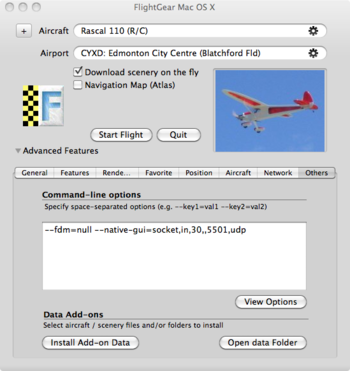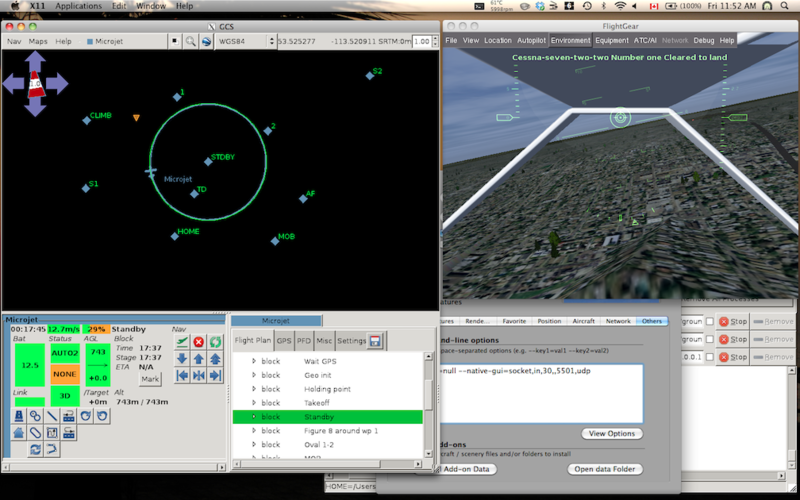Difference between revisions of "Installation/MacOSX"
| Line 32: | Line 32: | ||
This was in fact the process used to check that the code installed on a clean machine. | This was in fact the process used to check that the code installed on a clean machine. | ||
== | == Keeping source files for debugging == | ||
If you wish to debug code using the source install then you'll find that many of the source files for the libraries are missing. | If you wish to debug code using the source install then you'll find that many of the source files for the libraries are missing. | ||
Revision as of 16:15, 4 February 2011
The task of building Paparazzi on for Apple MacOS X is on going.
The current installation instructions are as follows. As the process evolves and the more people begin to use it the process will become easier and more simplified.
Installing from source
The tools that are required to work with paparazzi on a Mac are installed from MacPorts.
If you already have MacPorts installed it is advised to run the following steps before proceeding.
- sudo port selfupdate
- sudo port upgrade outdated
You can then run the installation steps below from step 3.
If you don't already have MacPorts installed run the following steps
- Install the latest XCode http://developer.apple.com/technologies/tools/xcode.html
- Install MacPorts from http://www.macports.org/install.php
- Install GIT
sudo port install git-core - Get a local copy of the Paparazzi Portability Support source
git clone git://github.com/paparazzi/paparazzi-portability-support.git - edit
/opt/local/etc/macports/sources.confand above thersync://...line addfile://<local path>/paparazzi-portability-support/darwin/macports/ports/ [nosync]for example:file:///Users/dummyuser/projects/paparazzi/paparazzi-portability-support/darwin/macports/ports/ [nosync]
- If you don't already have your own copy of the paparazzi source then you now need to install paparazzi
sudo port install paparazziIf you do already have your own copy of the paparazzi source and you want to keep in then the tools required by paparazzi can be installed with the commandsudo port install paparazzi-tools# then go and have lunch, get a coffee, get some sleep. this will probably take a long time
If you want to follow the standard Paparazzi Git install then the prerequisite software can be installed by running the command sudo port install paparazzi-tools
Trouble shooting
If you continually experience problems installing paparazzi or paparazzi-tools then it may be that you have some other conflicting software installed. i.e. an old version of a library in /usr.
One way to work around issues relating to prior MacPort installs that has been found is to clean out everything MacPorts has installed and install from scratch using the latest MacPorts
sudo port -f uninstall installedsudo port clean --all uninstalledsudo port selfupdatesudo port install paparazzi-toolsorsudo port install paparazzi
This was in fact the process used to check that the code installed on a clean machine.
Keeping source files for debugging
If you wish to debug code using the source install then you'll find that many of the source files for the libraries are missing.
This is because MacPorts cleans up the build artefacts and and source files after the installation is complete. This behaviour can be changed by adding the -k option to the port command.
For example:
sudo port -k install paparazzi-tools
This will result in all of the source and build artefact files being left on the hard disk.
Should you later wish to clean up these files you can do so with the clean command.
For example:
sudo port clean installed
Installation using the binary installer
- Install the latest XCode http://developer.apple.com/technologies/tools/xcode.html
- Download the paparazzi binary installer from http://TODO find a place to host this file
- Install paparazzi by double clicking on the downloaded file paparazzi.mpkg
If you want to follow the standard Paparazzi Git install then the prerequisite software can be installed by downloading the paparazzi-tools binary installer from http://TODO find a place to host this file and installing the tools by doublclicking on the downloaded file paparazzi-tools.mpkg
Running Paparazzi
Paparazzi can be started in the usual way
cd ~/paparazzi ./paparazzi
Changing the GTK look and feel
Run /opt/local/bin/switch2 to select a different theme. More detailed instructions can be found at http://gtk.php.net/manual/en/html/tutorials/tutorials.installation.macosx-stepbystep.html
Additional themes can be downloaded from http://art.gnome.org/themes/gtk2
USB Drivers for Telemetry
No drivers need to be installed in order to program either the STM32 based or LPC2148 based autopilot boards (ie TINY, TWOG, Booz, Lisa/L, Lisa/M) using a USB port. However telemetry between the vehicle and ground control station requires a modem. On an Apple Mac this will generally be connected to a USB port. Whatever modem is used it will be necessary to load drivers that allow Paparazzi to communicate with the modem. It is not possible to describe all possible modems and their configuration. However the most commonly used chipset for USB to serial communication is produced by FTDI. Below is described the installation of the FTDI drivers. This can be used as a guide for installing drivers for modems using other chipsets.
FTDI drivers can be downloaded from FTDI
The device will probably become available as something like /dev/tty.usbserial-000013FD when connected. Note that different USB ports get different addresses. When connecting to another port the same device came up as /dev/tty.usbserial-000014FA
Since Paparazzi is currently configured to use /dev/ttyUSB0 it's easiest to just create a link to the required device.
- Remove all USB devices from the computer and run the command
ls -l /dev/*usb* /dev/*USB*hopefully this will not list anything - Plug in your radio and repeat the command
ls -l /dev/*usb* /dev/*USB*this should now list the serial port that the radio has been connected to. In my case I getls -l /dev/*usb* /dev/*USB*
- crw-rw-rw- 1 root wheel 11, 27 20 Jan 14:38 /dev/cu.usbserial-000013FD
- crw-rw-rw- 1 root wheel 11, 26 20 Jan 14:38 /dev/tty.usbserial-000013FD
- Next we need to create a symbolic link to the tty.usbserial device listed to /dev/ttyUSB0 in my case the command is
sudo ln -s /dev/tty.usbserial-000013FD /dev/ttyUSB0 - To check that everything is correct run the first command again
ls -l /dev/*usb* /dev/*USB*and you should get something like thisls -l /dev/*usb* /dev/*USB*
- crw-rw-rw- 1 root wheel 11, 27 20 Jan 14:38 /dev/cu.usbserial-000013FD
- crw-rw-rw- 1 root wheel 11, 26 20 Jan 14:38 /dev/tty.usbserial-000013FD
- lrwxr-xr-x 1 root wheel 0 20 Jan 14:42 /dev/ttyUSB0 -> /dev/tty.usbserial-000013FD
Once the FTDI driver (kernel extension) is loaded it takes over for all FTDI connections. This means that it will not be possible to program the Lisa/L or Lisa/M boards while the driver is loaded.
To unload the driver use the command
sudo kextunload/System/Library/Extensions/FTDIUSBSerialDriver.kext
This should not give an error. if it does then try again a few times after quitting programs that may have used the connection. If the driver still fails to unload then a reboot may be required.
When it comes time to connect the modem again you'll again need the driver loaded. This can be done with the complementary command
sudo kextload/System/Library/Extensions/FTDIUSBSerialDriver.kext
Installing FlightGear
FlightGear has been packaged for use on OS X. This package can be downloaded from: http://macflightgear.sourceforge.net/home/downloads/
There are currently two packages available. The one released March 18, 2010 (2.0.0) installs and runs properly on OS X 10.6. Follow the directions here for installation and basic usage. Additional documentation can be found here. The Development Snapshot from August 21, 2010 does not seem as stable (did not work properly when tried on one machine).
There is a patch available for crashes encountered on the splash screen, as detailed here: http://macflightgear.sourceforge.net/a-patch-that-prevents-fg-200-from-crash-on-launch-is-available
Once FlightGear is installed, the GUI launcher can be used to set common options. By clicking on the Advanced Features arrow, one can gain access to many more options as well as an interface to specify command line options (the Others tab). This is where one can specify the flight dynamics model and network connectivity required for visualizing Paparazzi simulations as described on the Simulation page.
- In Paparazzi Center, add to the simulator command the -fg option plus the IP address of the machine running flightgear in this case the loopback interace is used as Flightgear and Paparazzi are running on the same machine:
.../sw/simulator/launchsitl -a TJ1 -fg 127.0.0.1 -boot -norc
Note TJ1 is the name of the aircraft you must substitute this with the name of your aircraft.
- Launch Flight Gear with the following set in the others tab under advanced settings:
--fdm=null --native-gui=socket,in,30,,5501,udp
If it is night in FlightGear and you wish to view the simulation in daylight, follow the instructions on the Simulation page.

